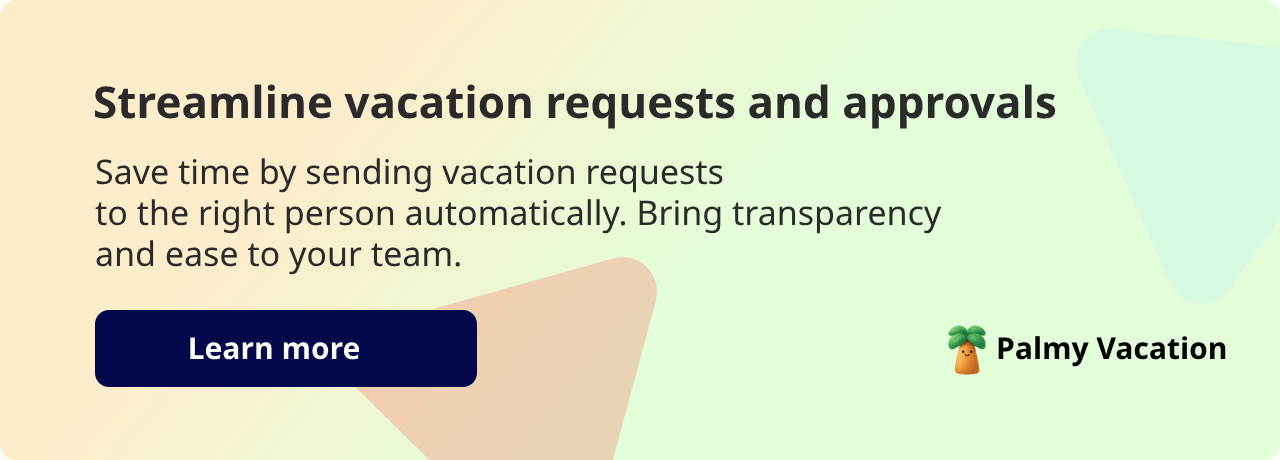Average PTO for small business: Are you competitive?
This post will explain what the data says about vacation time and PTO for small businesses, how those policies influence employee experiences, and why getting them right can make or break your team’s long-term health.


Why do so many small businesses hesitate when it comes to offering paid vacation time?
On the surface, vacation time should be simple - set up a vacation policy, tell people how many days they get, and move on. But in practice, time-off policies influence almost everything: employee satisfaction, retention, finances, legal compliance, and even company culture.
Many business owners who are struggling with tight margins and small teams choose to do nothing or stick with the bare minimum.
That’s a missed opportunity.
This post will explain what the data says about vacation time and PTO for small businesses, how those policies influence employee experiences, and why getting them right can make or break your team’s long-term health.
How many days are employees eligible for PTO?
According to a report from the U.S. Bureau of Labor Statistics (BLS), workers at small businesses (generally under 50 employees) get around 10 average paid vacation days per year after one year on the job. That’s not counting paid holidays or sick days - just pure vacation. For comparison, employees at large companies (500+ employees) typically get closer to 14 days in their first year, which aligns with the average vacation days reported across nationwide surveys.
But tenure is just as important. At five years, small business employees' average vacation time is about 13–14 days, while those with 20 years under their belt may reach 17 days. Larger companies, on the other hand, often go well beyond that, with some long-timers getting 24 days or more.
Why do small businesses offer less? Well, it’s not always about being stingy.
Big companies usually have big budgets, larger teams for coverage, and formalized HR systems to track leave. Small firms run lean, so losing just one or two people for a week can disrupt the whole operation. There’s also less formal HR support, meaning many small businesses stick to the basics to avoid administrative headaches.

Regarding sick leave, the national average hovers around 7 paid sick days per year for full-time private-sector workers. But in the smallest businesses, not every employee even has paid sick leave. About 70% of workers at the smallest firms have access to paid vacation, compared to over 90% at the largest companies.
That means some small business employees (especially part-timers or hourly staff) may be left without formal paid leave altogether.
That said, things seem to be changing. Since hiring is getting harder and workers expect more from their employers, some businesses are waking up to the fact that a good PTO package is a good business decision. And as we’ll see next, how that time off is structured matters just as much as how much PTO is offered.
Time off in small companies: Accrual, Lump Sums, and “Use-It-or-Lose-It”
Small businesses generally handle PTO in one of two ways: accrual or lump-sum.
In an accrual system, employees earn vacation gradually, usually with each pay period, which works out to one vacation day per month and adds up to 12 average pto days a year. It’s fair, it’s predictable, and it limits risk - if someone leaves after two months, they’ve only earned two days. For small businesses, this setup keeps things proportional and easier to manage financially.
On the flip side, lump vacation policies front-load PTO. At the start of the year or work anniversary, employees get their full batch of vacation days (say, 10 or 15) right away. Employees love the flexibility, but if they use up all their days in the first few months and then quit, the business might be left trying to recoup that time (if the policy even allows for it).
Some companies let unused vacation time roll over into the next year, either fully or up to a cap, which works great for employees who wanna save up for a big trip or a rainy day. Some, though, impose a hard cutoff: if you don’t use your vacation by year-end, you lose it. This helps avoid carrying unused PTO as a liability, but it can create a “December rush” when everyone wants to take time off.
These structures have a huge impact on small teams. Imagine a 10-person shop, and two folks wanting the same week off during peak season. With essentially no coverage, the employer has to find a way to be both fair and operational.
That’s why small businesses usually tweak their policies as they go, adjusting accrual rates, setting clear rollover limits, or even offering bonus days to smooth out busy stretches - all factors that can improve employee engagement.
If you want to avoid balancing vacation approvals, BuddiesHR’s Palmy Vacation can help you manage time off requests transparently right inside Slack. Set it up in minutes and streamline your PTO tracking. Download it here for free.
What small businesses are (and aren’t) obligated to provide
Did you know that federal law doesn’t actually require U.S. businesses to offer paid vacation or PTO?
That’s right - small businesses technically have a blank slate when it comes to designing (or skipping) vacation pay policies. But before you think, great, I don’t have to offer anything, hold up; state and local laws tell a different story, especially when it comes to paid sick leave.
Over the past decade, states like California, New York, Massachusetts, Arizona, and Rhode Island have introduced their own rules. Most now require even the tiniest businesses to provide paid sick time. We’re talking as small as a one-person shop in California. No one’s too small to follow the rules.
Failing to obey these local laws can easily land you in legal hot water, from fines to employee disputes. This is where some small businesses stumble as they assume federal law is the only thing that matters, forgetting that local laws might actually demand more.
What about paid vacation or personal days? In most states, those are optional, though if you do offer them, states like California regulate how they’re handled (for example, banning “use-it-or-lose-it” and requiring payout if someone leaves).
The takeaway is simple: check your state and local laws carefully. Don’t assume that because you’re small, you’re exempt. Paid sick leave laws, in particular, have changed over the years, so make sure you're familiar with the details.
Unlimited PTO: Does it work for small teams?
Lately, some companies (especially startups and tech firms) have adopted unlimited PTO policies. From a financial angle, it helps them reduce the admin work of tracking days and avoids paying out unused vacation when someone leaves. On paper, it’s a win-win.
But unlimited PTO often doesn’t work the way it's intended to.
Weirdly enough, with unlimited paid time off pto, some employees take less time off, not more. Without any guidelines, people start wondering:
- "How much is too much?"
- "Will it look bad if I disappear for two weeks?"
With this mindset, some start holding back - not because they can’t leave, but because they’re unsure what’s “okay” when it comes to taking paid vacation employees need.
Besides that, in a small team, every absence is noticeable. Without a set PTO structure, it’s easy for managers to unconsciously favor certain employees’ requests or let important people burn out because they never truly unplug.
The companies that offer unlimited pto and do make it work are the ones with set rules. Maybe it’s a minimum number of days off or closing the office for a full week every December. Some even offer a bonus, like $500 if you take at least five days off in a row, just to make sure people actually take advantage of the benefit.
Unlimited PTO can be great, but only if you introduce it with honest communication, good management, and a culture that actively encourages true rest. Without that, “unlimited” becomes just another word that looks good on paper but falls flat in practice.
If you’re experimenting with flexible PTO, pair it with good systems. BuddiesHR’s tools let you automate reminders, approvals, and visibility so unlimited time off doesn’t turn into unlimited confusion. Start a free trial to explore.

The cost of unused vacation days
From a financial standpoint, unused accrued vacation time shows up as a liability on the balance sheet. Depending on your state, if someone quits or gets let go, you might owe them a payout for all that banked PTO. That can mean thousands (or even tens of thousands) of dollars ready to hit your budget when you least expect it.
When vacation days employees are entitled to go unused, it’s not some badge of loyalty or hard work, but burnout waiting to happen. Creativity and energy drop, people get disengaged, and, eventually, they leave.
The best company environments track PTO balances and check in with employees who haven’t taken time off. Some set minimum vacation usage requirements or send periodic reminders encouraging people to plan time away.
Others create shared calendars or systems (usually inside their HR tools) to make sure time-off requests are processed properly and no one feels guilty about stepping away.
What time off means for the company culture and retention
Want to know one of the best clues that a company’s culture is in great shape? Watch how people take time off.
A thoughtful PTO policy does more than hand out a certain number of days. It sends a message: We trust you. We care about your well-being. We want you here for the long haul.
Research shows that employees who use their vacation time are more satisfied, less stressed, and more likely to stay with their employer. In fact, some studies even link paid time off to turnover rates that are up to 35% lower, which is a huge deal for businesses where every single employee is important.
Why does time off matter so much? Because it touches every part of the employee experience. If people feel guilty about asking for vacation or dread the mountain of work waiting when they get back, they start seeing the company as rigid or unsupportive. Over time, resentment builds up.
But when businesses encourage time away, managers lead by example, and teams that cover for each other, it creates a culture of trust. Employees feel like they’re valued as whole people, with time-off policies that help reduce the risks of physical and mental illnesses, not just as output machines.
You don’t have to outspend big corporations to compete. Even if you can’t offer the fattest paychecks, employee benefit policies like thoughtful PTO can make your workplace stand out. In a tight hiring market, a better work-life balance might be the reason someone stays (or the reason they walk away).
Avoiding burnout and keeping it fair in remote teams
Working remotely is not the same as taking a vacation. In fact, people working from home often have an even harder time unplugging because the line between “office” and “living room” is undefined. Without breaks, they’re just as likely (if not more) to burn out.
Managing remote employees or hybrid teams, the challenge is making sure PTO is tracked, approved, and shared fairly. When you’re not all in one place, it’s surprisingly easy for time-off requests to get missed or overlooked. That’s why having even something as simple as a shared calendar or an HR tool like we offer at BuddiesHR can help everyone see who’s off and when, making scheduling transparent.
Another key point: treat remote PTO exactly like on-site PTO. Don’t expect people to “check in” from vacation just because they have Wi-Fi. Set the expectation that time off is time off; no surprise Slack pings or project nudges.
Finally, watch for uneven patterns. In some remote teams, a few people might shoulder the extra load while others take more time away. You can prevent that resentment by watching for those patterns and making sure everyone gets the chance to rest. No matter where someone works, they deserve time to recharge.
For remote teams juggling standups, check-ins, and vacations, BuddiesHR’s Stany Standup automates daily reports right in Slack so you can keep everyone aligned without wasting time. Install it now and give your team back hours each week.
Wrap-Up
Paid time off is a reflection of your values as an employer.
When you treat PTO as an investment, not just a perk, you build a healthier, more engaged team that wants to keep working for you. While you might not match big-company budgets, you can offer something as powerful: a workplace that respects people’s time, well-being, and personal lives.
Now’s a great moment for business leaders to rethink their approach to vacation, sick leave, and time off. Done right, these policies strengthen your culture, boost retention, and help you match what businesses nationwide provide in PTO. That’s the kind of workplace where everyone wins.





